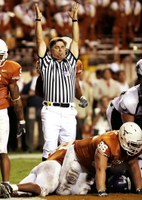Prairie Fare: Snacking tips for sports fans
(Click an image below to view a high-resolution image that can be downloaded)
Imagine yourself watching your favorite sport, whether at home in your favorite chair or at the game in the stands.
What snack might you be enjoying? How about a beverage choice?
As the game proceeds, you may have discovered your bag is empty. You might not remember tasting the food beyond the first bite or two.
When we are distracted, we might not recognize when we have had enough to eat.
The players on the field or court, of course, are burning lots of calories. We spectators are not.
Cheering doesn’t burn a lot of calories unless you are jumping up and down continuously. That practice might not earn you fans.
Many snacks are high in salt, saturated fat, added sugar and calories, which we all know we need to limit. Beverages such as pop and beer may be refreshing, but they can contribute about 150 calories per 12-ounce can. The calories add up after two or three.
Many snack foods fall in the ultraprocessed food category, which has limited nutritional value despite having multiple ingredients such as preservatives and other additives. These foods are designed to tempt our taste buds.
Unfortunately, mindless eating can result in consuming more calories than we need. Too many calories can lead to gaining weight, which may not be your goal.
Sometimes, we may feel like we are hungry, but we are actually thirsty. Before indulging in snacks, have a glass of ice water. If you like the crunchy sensation, opt for lower-calorie foods, such as apple slices, carrot sticks and popcorn.
Here’s the good news. You can slim down a lot of recipes with your ingredient choices.
- If you like spinach and artichoke dip, use light sour cream or plain yogurt in the dip and whole-grain bread for dipping.
- If you love meatballs, start with extra lean beef or pork. Drain the excess fat after cooking.
- Try making baked skinless chicken nuggets instead of wings.
- Make your own snack mix with dried fruit, whole-grain cereal and unsalted or lightly salted nuts.
Occasional treats are certainly enjoyable. Just as athletes need a playbook, sports fans can use a snacking playbook. Here are some winning tips:
- Serve yourself the amount of food equal to one serving from the Nutrition Facts label.
- Eat from a smaller plate instead of directly from the bag or container.
- When your plate is empty, stop. Drink water.
- Eat slowly. Remember, your brain needs about 20 minutes to get the message that your stomach is full.
- At a buffet, take control of the amount of high-fat and high-calorie items you consume. Have seconds of vegetables.
- Practice mindful eating. Pay attention to what you are eating, and enjoy its taste and aroma.
- As the host, downsize serving utensils and containers to invite your guests to smaller portions.
- Keep a check on how much you have eaten. Keep the glasses or cans in front of you. If you like chicken wings, keep the bones on your plate so you know what you have eaten.
- Take a movement break (like walking around or stretching) during breaks in the game.
Try this tasty dip as a way to enjoy more veggies as snacks. Visit www.ag.ndsu.edu/food for more ideas.
Spinach Dip
1 (10-ounce) pkg. frozen, chopped spinach
1 (1.5-ounce) pkg. dry vegetable soup mix
1 carton (8-ounce) fat-free sour cream
1 cup mayonnaise, canola- or olive oil-based
1 (8-ounce) can water chestnuts, drained, rinsed and chopped
¾ cup sliced green onions, including tops
2 round loaves sourdough bread, unsliced
Thaw spinach overnight in the refrigerator; drain and squeeze until fairly dry. Combine spinach, sour cream, mayonnaise, water chestnuts, soup mix and onions. Refrigerate. Best eaten the same day. Slice off the top third of one loaf of bread; hollow out the inside. Cut the removed bread and second loaf into 1½-inch cubes. Fill hollowed-out round bread loaf with spinach mixture. Place the cubed bread cut from the loaf around the outside for dipping.
Serves 16. Each serving has 290 calories, 35 grams (g) carbohydrate, 13 g fat, 7 g protein, 3 g fiber and 600 milligrams sodium.
(Julie Garden-Robinson, Ph.D., R.D., L.R.D., is a North Dakota State University Extension food and nutrition specialist and professor in the Department of Health, Nutrition and Exercise Sciences.)
NDSU Agriculture Communication – Oct. 2, 2025
Source: Julie Garden-Robinson, 701-231-7187, julie.garden-robinson@ndsu.edu
Editor: Dominic Erickson, 701-231-5546, dominic.erickson@ndsu.edu




